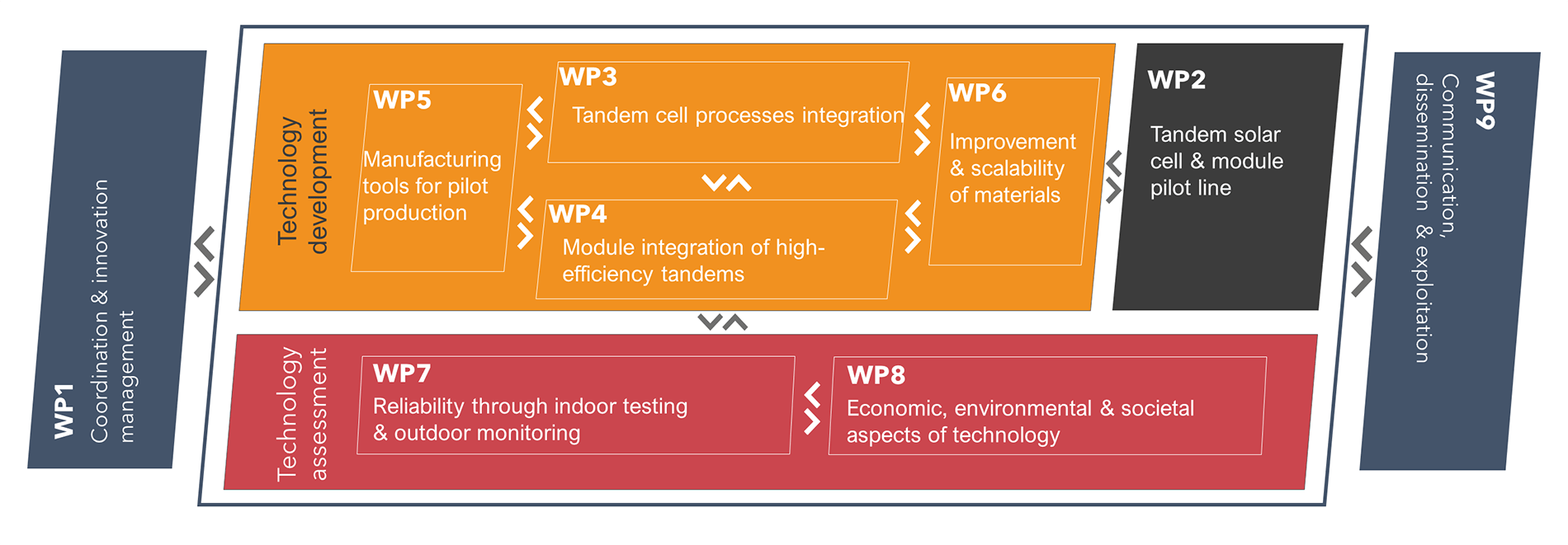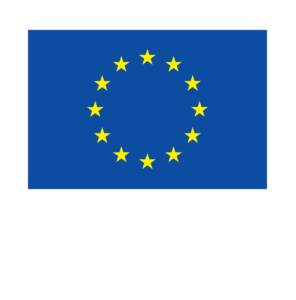- PEPPERONI implementation
PEPPERONI work occurs on different levels with a continuous exchange between key players of PV innovation. We implement activities through nine Work Packages (WPs), seven of which are technical, one dedicated to project coordination and one to outreach.

- Technology development
WPs closely interact through a regular exchange of samples, ideas and data. Cell and module process developments will give inputs on how to improve the tools and materials. In turn tool upgrades and new or improved materials are provided for the process developments.
Lead: Helmholtz-Zentrum Berlin für Materialien und Energie (HZB)
WP3 develops and integrates all processes necessary to produce high-efficiency and long-term stable tandem cells. Within WP3 we plan to:
- develop tandem cells based on adapted Q.ANTUM bottom cells
- develop dry, wet, or hybrid process for perovskite absorbers
- evaluate and develop the best buffer, contact layers, and front electrodes
- integrate processes in tandems with high efficiency and stability in the lab with scalable processes
- provide feedback on the tool and material requirements for pilot-line manufacturing and transfer process recipes for pilot-line integration
- device characterisation, simulation and loss analysis
Lead: Swiss Center for Electronics and Microtechnology (CSEM)
WP4 focuses on the integration of the high-efficiency devices produced in WP3 into modules. Within WP4, we plan to:
- identify the materials and processes to interconnect and encapsulate the high-efficiency cells of WP3 with minimal CTM losses
- continuously simulate, analyse, and minimise CTM losses
- ensure compatibility of the developments of WP4 with the pilot line requirements
- integrate novel materials, give guidelines on potential upgrades of tools for tandem module production in the pilot line, ensure that the encapsulation processes developed here provide suitable protection during reliability testing and transfer industry-relevant devices for further analysis
Lead: Qcells (QC)
WP5 develops, designs and fabricates manufacturing tools and/or tool upgrades that are required to ramp-up the tandem solar cell and module pilot line. Within WP5 we plan to design:
- physical vapour deposition (PVD) components for different layers
- a slot-die coater for perovskite and contact layers
- a cell interconnection equipment compatible with the interconnection processes and pilot line requirements
- a lamination equipment compatible with the lamination processes and pilot line requirements
- metrology tools and protocols for process and quality control during pilot line operation
Lead: Kaunas University of Technology (KTU)
WP6 develops improved materials for cell and module fabrication and ensures the scalability of material production. Within WP6 we plan to:
- develop optimal contact layer and absorber materials for the perovskite cell of the tandem device
- develop encapsulant materials and films for modules made with perovskite cells
- upscale materials manufacturing
- define parameters and the associated metrology that allows for quality control of materials needed for cell and module production
- Technology assesment
Samples and know-how obtained in the technology development WPs are used not only to test and assess the operational stability of the tandem solar cells but also to evaluate the environmental and societal impacts of the technology.
Lead: University of Ljubljana (ULjub)
WP7 explores potential degradation mechanisms of the cells and modules produced in PEPPERONI and uses these insights to ensure that these devices are stable when tested both indoors and outdoors in various climatic conditions. Within WP7 we plan to:
- develop tandem-specific accelerated aging tests
- perform and analyse IEC and ISOS qualification tests on cells and modules
- analyse the long-term stability of the devices in the laboratory, including their reverse bias/hot spots, PID, and LeTID tolerance
- monitor the outdoor performance of mini- and full-size modules installed in different locations
- develop performance forecasting tools based on the analysis of the outdoor performance data and the development of a detailed energy yield model
Lead: INERIS
WP8 carries out an economic assessment and a broad and interdisciplinary analysis of the societal challenges associated with the large-scale development of tandem PV technologies. Within WP8 we plan to:
- assess the cost of ownership (CoO) and levelized cost of electricity (LCoE) of the technology
- develop a LCA and to identify the levers to reduce environmental impact
- assess the potential hazardousness classification of future wastes and the possibility to target zero-waste perovskite/Si tandems through recycling
- identify strategic issues linked to raw materials access
- assess the economic costs and benefits of these technologies, both from the society point of view and from the citizens/consumer point of view
- Pilot line
The pilot line will feature innovative equipment, processes and materials developed within technology development WPs. The PEPPERONI’s pilot line will be an upgrade of the R&D line of Qcells in Thalheim, Germany.
Lead: Qcells (QC)
WP2 is set to design, ramp-up and operate a perovskite/Si tandem pilot line that will lay foundations for new production capacity in Europe. Within WP2 we plan to:
- setup the critical infrastructure and operations for a tandem cell and module pilot line
- move-in and ramp-up new equipment for cell and module fabrication
- implement the most promising tandem solar cell processes in the cell pilot line
- demonstrate a system prototype of pilot line for tandem cell (TRL7)
- implement the most promising tandem module processes in the module pilot line
- demonstrate a system prototype of pilot line for tandem module (TRL7)
- implement adequate metrology for inline process control and establish industry measures for process optimisation
- Coordination & outreach
Innovation development is a complex task that requires resource-sensible coordination and a clear strategy to further ensure the impact. Technical WPs of PEPPERONI are supported in this matter by dedicated to coordination and outreach WPs.
Lead: Helmholtz-Zentrum Berlin für Materialien und Energie (HZB) & Qcells (QC)
WP1 ensures the timely and smooth implementation of PEPPERONI activities. Within WP1 we plan to:
- coordinate the work and enable effective project organisation and administration
- develop a data management plan (DMP) to ensure implementation of the FAIR data concept
- control the work quality and to assess potential risks and execute contingency plans
- deliver timely reporting and financial management and to monitor the appropriate use of resources
- manage the innovation process and identify new opportunities
Lead: accelopment Schweiz (accelCH)
WP9 ensures a wide outreach of the project results and raise awareness among multiple stakeholder groups. Within WP9 we plan to:
- define and plan the outreach strategy to ensure the widest possible impact of the project results through a multi-stakeholder plan for the dissemination and exploitation including communication activities.
- deliver cross-media communication activities to raise awareness of the importance of tandem PV
- plan and implement stakeholder-oriented dissemination measures to spread the PEPPERONI results to the scientific community, policy makers, industry and relevant market sectors and application areas
- develop exploitation strategies and measures through continuous innovation management to facilitate future commercial and non-commercial use of the PEPPERONI results
- PEPPERONI progress
Project partners collaborate closely to ensure the successful implementation of different tasks. The processes, methods and outcomes of the work from different WPs are included in reports, so-called deliverables. These, numbered based on their WP origin, showcase the progress.
Managing the PEPPERONI project
Innovation development is a complex task that requires resource-sensible planning and implementation.
Read MoreThe PEPPERONI Handbook
Focus on facilitating coordination and implementation of activities within the project.
Read MoreIncreasing Outreach - the PEPPERONI website
An online presence is not only a requirement from the European Commission but is imperative for R&I projects.
Read MoreManaging project outcomes
Describes how data is generated, collected and processed within the PEPPERONI project.
Read MoreStrategic Plan for Impact
A comprehensive Plan for Dissemination and Exploitation, including Communication activities.
Read Morelab-scale slot-die coater
Parameters and installation process of lab-scale slot-die coater for perovskite and contact layers.
Read MoreImproved silicon bottom cell
PEPPERONI tandem solar cells consist of an improved silicon bottom cell and a perovskite top cell.
Read MoreInterconnection of tandem solar cells
Presents insights into the interconnection of perovskite/silicon tandem solar cells.
Read MoreDevelopment of the evaporation concept
Appropriate concepts for physical vapour deposition tools suitable for perovskite/Si tandem pilot manufacturing.
Read MoreAccelerated test strategy
Accelerated test strategies for perovskite/Si tandem cells and modules reported on the current state-of-the-art.
Read More

